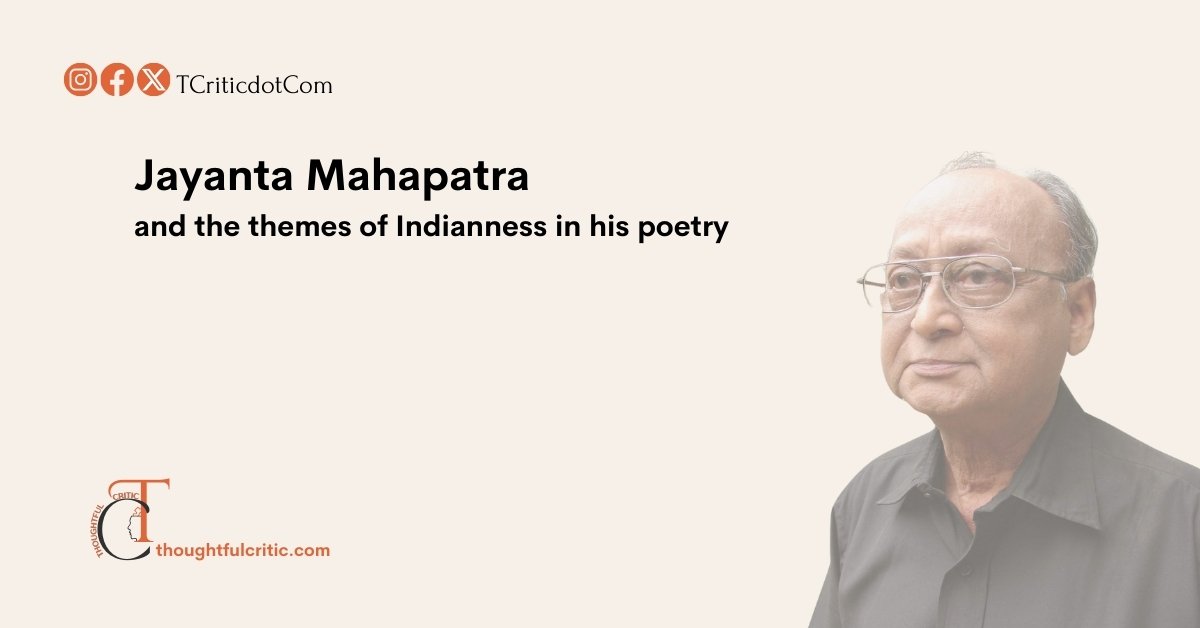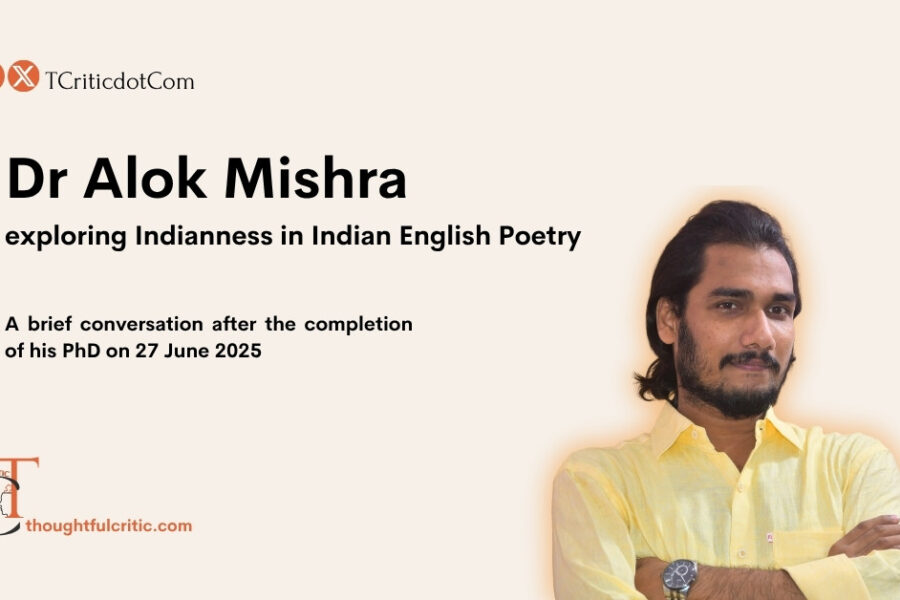Jayanta Mahapatra’s engagement with Indianness and the themes that exhibit Indian ethos is a cornerstone of his poetic oeuvre, reflecting a profound exploration of cultural identity, regional specificity, and existential dilemmas. Rooted in the landscapes and myths of Odisha, his poetry transcends regional boundaries to articulate a broader Indian sensibility, blending local traditions with universal human concerns. Mahapatra’s work is deeply informed by his bilingual identity—an Odia poet writing in English—which allows him to navigate the complexities of postcolonial India while asserting a distinct cultural voice. His poetry, as Bijay Kumar Das observes, “acclimatises an indigenous tradition to the English language,” creating a hybrid idiom that resists Western literary norms while celebrating India’s cultural diversity (Das 24). This synthesis of the local and the global is evident in his recurring use of Odia myths, rituals, and landscapes, which serve as metaphors for broader existential and socio-political themes.
Mahapatra’s exploration of Indianness is deeply tied to his engagement with Odisha’s cultural and spiritual heritage. The Jagannath Temple in Puri, the ruins of Konark, and the Mahanadi River are not merely backdrops but active symbols of cultural memory and identity. In Dawn at Puri, he juxtaposes the sacred imagery of the temple with the stark reality of poverty: “A skull on the holy sands / tilts its empty country towards hunger” (A Rain of Rites). This blending of the sacred and the profane reflects his negotiation between tradition and modernity, a theme central to his portrayal of Indianness. Critics like Bruce King note that Mahapatra’s work “asserts a postcolonial identity distinct from Anglo-American norms,” emphasising the importance of regional specificity in shaping a national literary voice (King 194). His poetry, therefore, becomes a site where the local and the national intersect, offering a nuanced understanding of Indian identity that is rooted in place yet resonant with universal themes.
His exploration of myth and history is at the heart of Mahapatra’s engagement with Indianness. His poems often reimagine Indian myths, such as the legends of Puri’s Jagannath Temple, to interrogate contemporary realities. In The Temple Road, Puri writes: “Stream of common men on the road to the temple / and the form of their prayer” (The Temple Road, Puri), blending the ritualistic past with present-day struggles. As Ashok Bery observes, this layering of myth and history reflects a “postmodern indeterminacy,” where time becomes cyclical rather than linear, and the past continually informs the present (Bery 305). By re-enacting myths, Mahapatra critiques modernity and reaffirms the enduring relevance of India’s cultural heritage. His use of myth, however, is not merely nostalgic; it is a means of grappling with the complexities of identity in a rapidly changing world.
A deep humanism and empathy for marginalised voices also mark Mahapatra’s portrayal of Indianness. His poetry confronts the harsh realities of Indian society—poverty, corruption, and gender inequality—with unflinching honesty. In Hunger, he depicts the exploitation of a fisherman’s daughter: “I hear the soft grunt of the fisherman’s daughter / as the men rifle through her skeletal flesh” (A Rain of Rites). This visceral imagery critiques systemic oppression, particularly women’s marginalisation while underscoring his themes’ ethical urgency. Critics like Syamsundar Padihari identify a “tragic consciousness” in Mahapatra’s work as he lays bare the “incongruities and lacunas” of Indian culture (Padihari 173). His focus on suffering, however, is not without its critics. Some argue that his emphasis on despair risks overshadowing moments of resilience or hope, reducing his portrayal of Indianness to a monochromatic narrative of tragedy.
Jayanta Mahapatra’s poetry has provoked a broad spectrum of critical interpretations concerning its embodiment of “Indianness.” Scholars engage in an ongoing debate as to whether Mahapatra’s work represents an authentic expression of Indian sensibility or if it merely reifies an orientalist construct by relying on conventional stereotypes. The divergent viewpoints reflect both an acknowledgement of the poet’s deep-rooted engagement with his native milieu and a critique of the ambiguous, sometimes circular, ways his Indian identity is portrayed.
Critics such as Syamsundar Padihari affirm that Mahapatra is “a true poet of the soil,” underscoring his profound connection to his native land and his enduring fascination with Indian heritage, myths, and legends (Padihari). For Padihari, the strength of Mahapatra’s poetry lies in its intimate and continuous engagement with the environment, culture, tradition, and even the mental landscapes inherent to India. This fidelity to his native environment is a backdrop for personal expression and a vital element in constructing a broader, collective identity that transcends individual experience.
Madhusudan Prasad similarly situates Mahapatra’s poetic sensibility within the socio-cultural heritage of India, particularly emphasising the depiction of the Oriya landscape. Prasad contends that while Mahapatra’s work is imbued with his region’s local realities and cultural narratives, it often assumes a sombre and even tragic tone (Prasad). This melancholic dimension, according to Prasad, enriches the texture of the poetic narrative and reflects the complexities and inherent struggles of the cultural and physical environment from which it emerges.
Complementing these culturally affirming perspectives, Bruce King introduces a critical framework that locates Mahapatra’s work within the context of decolonisation. King argues that Mahapatra’s poetry represents a significant shift—a decolonisation of perception that distinguishes Indian English poetry from its British antecedents (King). In this view, Mahapatra’s emphasis on subjective memory and introspection signals a move away from the self-enclosed art forms typical of post-modernism. Instead, his work invites readers to consider a personal and deeply interwoven narrative with the socio-historical fabric of post-colonial India.
A further layer of complexity is provided by the observations of A.K. Ramanujan, who problematises the very notion of a singular “Indian sensibility.” As cited by some critics, Ramanujan challenges the idea of a uniform Indian way of thinking by deconstructing the implicit binaries that often segregate the West from the East—materialism versus spirituality, rationality versus intuition (Ramanujan). By dissecting the language of the question, “Is there an Indian Way of Thinking?”, Ramanujan reveals the inherent ambiguity and multiplicity of thought that defies any monolithic categorisation. In doing so, he aligns with perspectives that view Mahapatra’s work as reflecting spiritual and intuitive qualities traditionally associated with India while acknowledging the limitations of such broad generalisations.
Bijay Kumar Das offers another nuanced perspective by viewing Mahapatra’s oeuvre as an endeavour to adapt Indigenous traditions to the English language. Das argues that Mahapatra is consciously engaged in the creation of a new Indian English idiom that is both reflective of his personal heritage and resonant with national myths and historical narratives (Das). By setting his work within the specific context of Orissa and its cultural milieu, Mahapatra is seen not only as a regional poet but also as one who actively negotiates his identity concerning the more prominent national landscape.
K. Ayyappa Paniker contributes to this discourse by emphasising that Indian poetry in English operates within a dual framework. According to Paniker, the “Indian” component may refer to the poet’s nationality, the work’s thematic content, or the underlying sensibility that informs the poetry (Paniker). In Mahapatra’s case, his deliberate incorporation of local colour and cultural echoes underscores his dual identity as an Orissan poet writing in English. This duality, Paniker suggests, further complicates any simplistic understanding of what constitutes “Indianness.”
The decolonising impulse in Mahapatra’s work is also notably discussed by P.P. Raveendran, who posits that Mahapatra’s poetry performs an act of resistance against colonial legacies. Raveendran views the poet’s work as comparable in its literary quality to the finest verses in Indian regional languages, asserting that Mahapatra is instrumental in establishing a native poetic tradition that repudiates colonial domination (Raveendran).
In contrast, a contingent of critics remains sceptical of Mahapatra’s invocation of “Indianness.” Some argue that the mysticism in his poetry indicates a quest for elusive, primordial experiences conveyed through dream-like, pre-linguistic imagery. These critics suggest that such a focus on mystical abstraction may obscure clarity, thus rendering the poetry deliberately opaque (Critics). Moreover, there is criticism that Mahapatra’s reliance on the concept of “Indianness” operates circularly: the vagueness of his imagery is taken as evidence of his Indian sensibility, which is then defined by the same obscurity.
Sandipan Ray Choudhury provides another critical angle by highlighting the tension between Mahapatra’s deep connection to his native soil and his critical engagement with its shortcomings. Choudhury contends that while the poet’s work is undeniably rooted in Indian culture, it also exposes the contradictions and inadequacies inherent in that cultural framework (Choudhury). This duality is emblematic of a broader post-colonial narrative, wherein an awareness of the underlying cultural tensions constantly tempers a reassertion of national identity.
Despite its limitations and critiques, Mahapatra’s engagement with Indianness remains a defining feature of his legacy. His bilingualism, evident in Odia-language poetry (e.g., Bali, 1993), further enriches his exploration of Indian ethos, showcasing his commitment to regional identity while contributing to a broader national discourse. As Subrat Kumar Samal notes, Mahapatra’s work “bridges the gap between the regional and the global,” offering a unique perspective on Indian identity that is both rooted and universal (Samal 48). His poetry, therefore, stands as a testament to the transformative power of art in navigating the complexities of cultural identity in a postcolonial world. By intertwining the personal and the universal, the regional and the national, Mahapatra crafts a body of work that continues to inspire and challenge readers, affirming his place as a cornerstone of Indian English literature.
Keep Reading: a detailed critical biography of Jayanta Mahapatra – The Indian Authors.
Works Cited (and Suggested Readings):
- Bery, Ashok. “Imagery and Imagination in the Poetry of Jayanta Mahapatra.” Literary Cultures in History: Reconstructions from South Asia, edited by Sheldon Pollock, University of California Press, 2003, pp. 298-310.
- Chaudhuri, Rosinka. A History of Indian Poetry in English. Cambridge University Press, 2016.
- Das, Bijay Kumar. Poetry of Jayanta Mahapatra. Atlantic Publishers, 1992.
- Das, Bijay Kumar. Poetry of Jayanta Mahapatra. 4th ed., Atlantic Publishers and Distributors, 2007.
- King, Bruce. Modern Indian Poetry in English. Oxford University Press India, 2001.
- Krätli, Graziano. “Keki Daruwalla and Gieve Patel.” Literary Cultures in History: Reconstructions from South Asia, edited by Sheldon Pollock, University of California Press, 2003, pp. 310-327.
- Mahapatra, Jayanta. Interview with Abraham. Indian Literature, vol. 40, no. 4, July-Aug. 1997, pp. 149-57.
- Mehrotra, Arvind Krishna. An Illustrated History of Indian Literature in English. Permanent Black, 2003.
- Padihari, Syamsundar. “Jayanta Mahapatra: The Poet of the Soil.” Indian Literature, vol. 51, no. 3, May-June 2007, pp. 168-76.
- Prasad, Madhusudan. “’Caught in the Currents of Time’: A Study of the Poe1ry of Jayanta Mahapatra.” Journal of South Asian Literature, vol. 19, no. 2, Summer-Fall 1984, pp.181-207.
- Samal, Subrat Kumar. Postcoloniality and Indian English Poetry: A Study of the Poems of Nissim Ezekiel, Kamala Das, Jayanta Mahapatra and A.K. Ramanujan. Partridge Publishing, 2015.
- Sinha, Arnab Kumar, et al., editors. Contemporary Indian English Poetry and Drama: Changing Canons and Responses. Cambridge Scholars Publishing, 2019.
Ashish M for Thoughtful Critic



